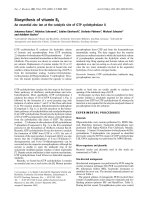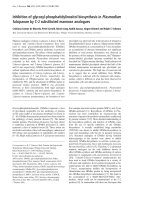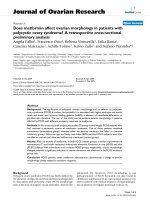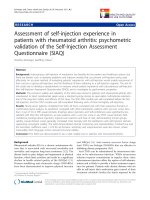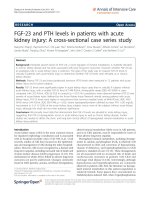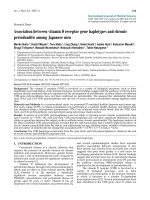Báo cáo y học: " Decrease of vitamin D concentration in patients with HIV infection on a non nucleoside reverse transcriptase inhibitor-containing regimen" doc
Bạn đang xem bản rút gọn của tài liệu. Xem và tải ngay bản đầy đủ của tài liệu tại đây (246.01 KB, 6 trang )
RESEARC H Open Access
Decrease of vitamin D concentration in patients
with HIV infection on a non nucleoside reverse
transcriptase inhibitor-containing regimen
Anali Conesa-Botella
1,2*
, Eric Florence
1
, Lutgarde Lynen
1
, Robert Colebunders
1,2
, Joris Menten
3
,
Rodrigo Moreno-Reyes
4
Abstract
Background: Vitamin D is an important determinant of bone health and also plays a major role in the regulation
of the immune system. Interestingly, vitamin D status before the start of highly active antiretroviral therapy
(HAART) has been recently associated with HIV disease progression and overall mortality in HIV-positive pregnant
women. We prospectively studied vitamin D status in HIV individuals on HAART in Belgium.
We selected samples from HIV-positive adults starting HAART with a pre-HAART CD4 T-cell count >100 cells/mm
3
followed up for at least 12 months without a treatment change. We compared 25-hydroxyvitamin D plasma
[25-(OH)D] concentration in paired samples before and after 12 months of HAART. 25-(OH)D levels are presented
using two different cut-offs: <20 ng/ml and <30 ng/ml.
Results: Vitamin D deficiency was common before HAART, the frequency of plasma 25-(OH)D concentrations
below 20 ng/ml and 30 below ng/ml was 43.7% and 70.1% respectively. After 12 months on HAART, the frequency
increased to 47.1% and 81.6%.
HAART for 12 months was associated with a significant decrease of plasma 25-(OH)D concentration (p = 0.001).
Decreasing plasma 25-(OH)D concentration on HAART was associated in the mul tivariate model with NNRTI-based
regimen (p = 0.001) and lower body weight (p = 0.008). Plasma 25-(OH)D concentrations decreased significantly in
both nevirapine and efavirenz-containing regimens but not in PI-treated patients.
Conclusions: Vitamin D deficiency is frequent in HIV-positive individuals and NNRTI therapy further decreases
25-(OH)D concentrations. Consequently, vitamin D status need to be checked regularly in all HIV-infected patients
and vitamin D sup plementation should be given when needed.
Background
Vitamin D status is an important determinant of bone
health. Vitamin D defi ciency increases the r isk of osteo-
porosis and fractures and in its most severe form causes
rickets in children and osteomalacia in adults. In addi-
tion, a large number of studies indicate that vitamin D
also plays an important role in insulin secretion, lipid
metabolism, autoimmune disorders, cell proliferation,
and cardiovascular diseases [1-8].
The main determinant of vitamin D status is the intra-
epidermal conversion of pre-vitamin D into vitamin D
by ultra violet radiation. As a consequence, increased
skin pigmentation and low sunlight exposure are risk
factors for vitamin D deficiency [2]. Cholecalciferol is
metabolized into 25-dihydroxyvitamin D [25-(OH)D] in
the liver and into its active form 1,25-dihydroxyvitamin
D [1,25-(OH )
2
D] in the kidney and peripheral cells such
as activated immune cells [8] by t wo successive hydro-
xylations by cytochromes P450 [9]. Both 1,25-(OH)
2
D
and 25-(OH)D are catabolized by the cytochrome
CYP24 [9]. In target cells such as immune cells,
1,25-(OH)
2
D is converted locally at the site of action
[8]. Due to its longer half-life of 15 days, 25-(OH)D is
considered the best marker of vitamin D status [8].
Although there is no agreement among international
experts on the most appropriate cut-off value for
* Correspondence:
1
Department of Clinical Sciences, Institute of Tropical Medicine, Antwerp,
Belgium
Full list of author information is available at the end of the article
Conesa-Botella et al. AIDS Research and Therapy 2010, 7:40
/>© 2010 Conesa-Botella et al; licensee BioMed Central Ltd. This is an Open Access article distributed under the terms of the Creative
Commons Attribution License ( which permits unrestricte d use, distribution, and
reproductio n in any medium, provided the original work is properly cited.
adequate vitamin D level, individ uals with 25-(OH)D
below 20 ng/ml are considered as deficient [2]. How-
ever, a value above 30 ng/ml has been suggested to be
associated in the general population with better health
outcomes such as higher bone mineral density, less falls
and fractures as well as protection against cancer [10].
Lower vitamin D level has recently been associated with
increased mortality in the general population [11] as
well as with HIV disease progression and overall mortal-
ity in a cohort of Tanzanian pregnant women with HIV
infection [12].
Paul et al. showed that vitamin D deficiency was more
prevalent among HIV-positive patients treated with
HAART when comp ared to HAART-naive patients and
negative controls [13], however, Ramayo et al. showed
opposite results [14]. In addition, HAART may impair
vitamin D metabolism [15,16] as shown by some in vitro
studies. Cozzolino et al. [16] demonstrated the inhibition
by protease inhibitors (PIs) of the 25-hydroxylase and the
1a-hydroxylase involved in vitamin D metabolism. Ellfolk
et al. [17] showed the inhibition of the 25-hydroxylase by
efavirenz, a n on-nucle oside r everse tra nscripta se inhibi-
tor (NNRTI).
Vitamin D deficiency and bone disease in HAART
patients [14,18,19] have been associated with NNRTIs
[20-22], as well as tenofovir [23,24], and PIs [19,24-26].
However, there is a lack of longitudinal studies on v ita-
min D variation during HAART; therefore we studied
vitamin D status in a longitudinal cohort study of AIDS
patients during the first year of HAART.
Methods
Subjects
Subjects were HIV-positive individuals belonging to the
outpatient cohort of the Institute of Tro pical Medicine
(IT M) in Antwerp, Belgium. Antwerp is situated on the
51
st
degree of latitude and receives 1000 hours of sun
per year, half the exposure seen at the equator.
Using the ITM coho rt electronic database we selected
retrospectively patients fitting the following criteria: (a)
HIV-positive adults starting HAART with CD4 T-cell
counts >100 cells/mm
3
; (b) followed up for at least
12 months; (c) without a treatment change in the first
year of HAART. Individuals with a CD4 T-cell count
below 100 cell/mm
3
were excluded as they are often
acutely unwell and may have other factors contributing
to vitamin D deficiency.
Individuals were started either on a PI-based or o n an
NNRTI-based regimen. Patients on NNRTI were ei ther
on Nevirapine (= 20) or on Efavirenz (n = 23). Sixty-six
percent (n = 29) of patients on PI were on a boosted regi-
men with Ritonavir. Twenty-seven individuals were tak-
ing Tenof ovir; 18 i n c ombination with NNRTIs and 8
with PIs. Patients taking corticosteroids, suffering from
“severe renal disease” or “severe liver disease”,orwithan
active granul omatous disease such as active tuberculosis,
sarcoidosis and Crohn’ s disease were excluded. “Severe
renal disease” was defined as urea and creatinine twofold
above the normal reference values. “Severe liver disease”
was defined as a patient having both elevated alanine
aminotransferase and aspartate aminotransferase 5 time s
above the normal reference values.
All subjects had signed an informed consent allowing
additional investigation for research purpose on the
stored plasma samples left over of routine blood testing.
The study was approved by the institutional review
board of the ITM.
Study design
We selected individua ls who had stored samples avail-
able at the s tart of HAART and 12 months later. We
compared paired pre-HAART and post-HAART sam-
ples. The pre-HAART sample was drawn between the
start of HAART and maximum 3 months before it.
The 12 months sample was drawn minimum 3
months before and maximum 3 months after 12
months of HAART.
Clinical data
Clinical data were extracted and analyzed anonymously.
We recorded the following variables: sex, skin color, sea-
son, age, weight, CD4 T-cell nadir and pre-HAART
CD4 T-cell level, viral load, HIV disease stage, HAART
regimen, total cholesterol, HDL-C, and LDL-C. No data
on non prescribed vitamin D supplementation or sun
exposure were routinely collected.
Laboratory analysis
Plasma samples were selected among stored samples
obtained between 1997 and 2009. Plasma had been iso-
lated by centrifugation of blood drawn on ethylenedia-
minetetraacetic acid (EDTA)-containing tubes and
aliquots had been kept in a -80°C freezer.
Total plasma 25-(OH)D was measured by radioimmu-
noassay (DiaSorin). The interassay coefficient of varia-
tion was 9-13%. The quality control was performed by
the vitamin D External Quality Assurance Survey
(DEQAS). All samples were measured in dupl icate. CD4
T-cell count was determined by standard flow cytometry
(FACScalibur, Becton Dickinson). Viral load was mea-
sured with the Cobas Amplicor HIV-1 (Roche). T otal
cholesterol, HDL-C, and LDL level were determined by
automated standard laboratory techniques.
Vitamin D status
Plasma 25-(OH)D concentrations are presented using
two different cut-offs, <20 ng/ml (50 nmol/l) and
<30 ng/ml (75 nmol/l).
Conesa-Botella et al. AIDS Research and Therapy 2010, 7:40
/>Page 2 of 6
Statistical analysis
All statistical analyses were performed with STATA and
R software. Pre-HAART data was summarized using
counts and percentages, means and standard deviations
for normally distributed data, and median (interquartile
range, IQR) for non-normal continuous variables. The
difference between PI and NNRTI groups was assessed
by Fisher’s exact test for percentages, t-test for means
and Mann-Whitney for medians. Normality was assessed
using graphical methods and confirmed by D’ agostino
and Pearson omnibus normality test. Within-group or
overall changes in vitamin D levels were assessed using
a paired t-test. Logistic regression or linear regression
methods were used to study the relation between the
predictors and vitamin D. A threshold of p < 0,1 was
used for variable inclusion in the multivariate model,
which was the n simplified by backward el imination.
P-values presented in the text refer to the final statistical
model obtained.
Results
Subject characteristics
Among the 194 patients fitting the inclusion criteria,
plasma samples were available at both pre-HAART and
12 months for 89 patients. Two patients were excluded
because of chronic liver disease. None of the patients
had renal insufficiency, a known granulomatous disease
or were treated with corticosteroids during the study
period. A mean ± SD of 381 ± 39 days was observed
between both time points.
The pre-HAART population characteristics are sum-
marized in Table 1. No significant differences at baseline
were observed between patients on PI and NNRTI-
based regimen. The “dark skin” group included 17 indi-
viduals from Central and Southern Africa; the ‘light
skin” group included 68 Caucasians, one Moroccan and
one Ecuadorian.
Risk of vitamin D deficiency in HIV individuals before
HAART
Before HAART, 43.7% and 70.1% of the individual s had
plasma 25-(OH)D concentrations below 20 ng/ml and
30 ng/ml, respectively. In multivariate analysis, dark-
skinned individuals had 8.9 and 11.2 times more risk
than light-skinned individuals to present with plasma
25-(OH )D concentrations below 20 ng/ml and 30 ng/ml
(p = 0,001 and 0,026), respectively. In addi tion, the pre-
valence of plasma 25-(OH)D concentrations below 30
ng/ml was higher in winter compared to summer (p =
0.001) and fall (p = 0.020). There was no significant
effect of gender, age, weight or HIV disease stage, pre-
HAA RT CD4 T -cell count or CD4 T-cell nadir, or viral
load on vitamin D levels.
Risk of vitamin D deficiency of HIV individuals
during HAART
After 12 months on HAART, 47.1% and 81.6% of indivi-
duals has plasma 25-(OH)D concentrations below 20
ng/ml and 30 ng/ml respectively. Individuals with a
darker skin color or being treated by a NNRTI-based
regimen presented an increased risk of having plasma
25-(OH)D concentrations lower than 20 ng/ml (respec-
tively 6 and 3 fold; p = 0,006 and p = 0,020). Individuals
with a low body weight were 4.7 times more at a risk of
having plasma 25-(OH)D concentrations below
30 ng/ml (p = 0,026). There was no influence of sex,
sampling season, pre-HA ART CD4-T cell count and
CD4 T-cell count nadir, viral load and HIV stage.
When analyz ing paired pre-HAART and post-HAAR T
samples from individuals on HAART for 12 months, we
observed a significant decrease of plasma 25-(OH)D con-
centration in the studied population (Table 2). The
decrease of 25-(OH)D was associated in the multivariate
model to NNRTI-based regimen (p = 0.001) and to a
lower body weight (p = 0.008). Moreover, plasma 25-(OH)
D concentration decreased signif icantly after 12 months
on NNRTI regimen (both on nevirapine and on efavirenz),
Table 1 Pre-HAART characteristics of the study
population
Variables NNRTI PI p
value
n = 43 N = 44
25-(OH)D (ng/ml) mean ± SD 26.6 ± 13.5 22.6 ± 8.9 0.101
Sex Male n (%) 38 (88.4) 34 (77.3) 0.256
Dark skin color n (%) 7 (16.3) 10 (22.7) 0.590
Pre-HAART
sampling
Winter n (%) 15 (34.9) 17 (38.6) 0.657
Spring n (%) 5 (11.6) 8 (18.2)
Summer n (%) 11 (25.6) 11 (25.0)
Fall n (%) 12 (27.9) 8 (18.2)
Age (years) median
(IQR)
38.6
(30.8;44.8)
37 (31.8;44.6) 0.929
Weight (Kg)
a
median
(IQR)
73 (68;85) 70.5 (65.3;83.5) 0.675
CD4 (cells/mm
3
)
Nadir median
(IQR)
224
(181;292)
247.5
(182;314.5)
0.61
pre-HAART median
(IQR)
254
(183;338)
299 (241;390.5) 0.052
Viral Load (log
10
) median
(IQR)
5.24
(4.95;5.53)
5.5 (4.97;5.86) 0.168
HIV stage (CDC)
A n (%) 31 (72.1) 32 (72.7) 0.640
B n (%) 8 (18.6) 6 (13.6)
C n (%) 4 (9.3) 6 (13.6)
PI: Protease inhibitors; NNRTI: non-nucleoside reverse transcriptase inhibitors;
SD: Standard deviation; IQR: Interquartile range;
a
n=85
Conesa-Botella et al. AIDS Research and Therapy 2010, 7:40
/>Page 3 of 6
but not in PI-treated patients (Figure 1).There wa s no
association between the use of tenofovir and a decrease in
vitamin D levels (p = 0.665; data not shown).
Changes in cholesterol HDL-C and LDL-C levels on HAART
After one year of HAART, we observed a significant
increase in cholesterol concentration (from 168.5 to
202.5 mg/dl; p < 0.001; data not shown) and HDL-C
levels (from 40.8 and 46.6 mg/dl; p = 0.002; data not
shown). LDL-C level did not increase significantly
(p = 0.168; data n ot shown). There was no association
between the increase of lipids and the pre-HAART vita-
min D status or with the type of HAART.
Discussion
Our study shows a high prevalence of vitamin D defi-
ciency in HIV-infected individuals as observed by others
[13,27,28]. As reported in the general population [2,29],
vitamin D deficiency during summer and fall was lower
than during winter.
We also showed that a NNRTI-based treatment was
associated with a significant decrease of 25(OH)D
plasma concentration after 12 months on HAART.
Similarly to our findings, Van den Bout-van den Beukel
[21] described a prevalence of vitamin D deficiency of
62% in dark-skinned individuals in a cross-sectional
study of HIV-positive individuals. In their study, patients
on an NNRTI-based therapy had lower vitam in D levels
than those on a PI-based therapy.
Decreased bone mineral density is often described in
cross sectional studies in patients on tenofovir (NRTI)
[23,30] or PIs [19,24-26]. However, we and others found
an association between NNRTI-based regimen and vita-
min D levels [21,22]. The lack of concordant findings on
the effect of HAART on bone mineral density and vita-
min D might result from the direct action of antiretro-
viral drugs on osteoclasts and osteoblasts [26,31,32].
The effect of NR TI drugs on vitamin D metabolism has
never been studied but interaction s are unlikely as
NRTIs are not metabolized by cytochromes [33]. In con-
trast, PI and NNRTI drugs have been shown to interfere
with cytochromes involved in the vitamin D metabolism
(e.g. NNRTI induce CYP3A4; PIs inhibit CYP3A4)
[9,16,17,33-35]. The role of each antiretroviral drug par-
ticularly f rom the NNRTI family on vitamin D metabo-
lism should be evaluated further to better understand
Table 2 Determinants of 25(OH)D (ng/ml) decrease
on HAART
Variable 25(OH)D (CI)
pre-HAART
25(OH)D (CI)
post-HAART
Adj p
Population 24.6 (22.1;27.0) 22.0 (19.8;24.1) 0.001*
Sex 0.668
M 25.6 (22.8;28.4) 22.8 (20.4;25.3)
F 19.6 (14.8;24.4) 17.8 (14.0;21.6)
Skin color 0.195
Light 26.7 (24.0;29.4) 23.6 (21.2;26.0)
Dark 15.8 (11.9;19.7) 15.3 (11.6;19.0)
Pre-HAART sampling 0.127
Winter 21.9 (18.1;25.6) 19.8 (16.2;23.5)
Spring 22.1 (16.5;27.6) 22.4 (19.3;25.5)
Summer 29.8 (24.2;35.4) 22.4 (19.7;29.0)
Fall 24.8 (19.1;30.5) 22.5 (16.8;28.2)
Age 0.644
<35 years 24.9 (21.0;28.7) 22.2 (18.6;25.8)
35-50 years 24.2 (20.2;28.2) 21.2 (17.8;24.5)
>50 years 24.8 (20.0;29.6) 24.2 (19.2;29.2)
Weight (Kg) 0.008
≤70 23.0 (19.4;26.6) 18.5 (16.2;20.9)
>70 25.8 (22.4;29.2) 24.8 (21.4;28.1)
CD4 (CD4/mm
3
) nadir 0.160
≤200 25.4 (21.0;29.8) 21.3 (18.2;24.5)
>200 24.1 (21.1;27.1) 22.3 (19.4;25.3)
CD4 (CD4/mm
3
) pre-HAART 0.174
≤200 25.9 (20.5;31.4) 21.5 (17.4;25.6)
>200 24.1 (21.3;26.9) 22.1 (19.5;24.8)
Viral Load (log
10
) 0.666
>5 25.7 (22.9;28.6) 22.9 (20.3;25.6)
≤5 21.7 (16.7;26.6) 19.6 (15.8;23.5)
HIV stage (CDC) 0.760
A 25.4 (22.4;28.4) 22.7 (20.0;25.3)
B 24.3 (18.0;30.5) 21.0 (15.7;26.4)
C 19.8 (13.0;26.5) 18.7 (11.8;25.6)
Therapy 0.001
NNRTI 26.6 (22.5;30.8) 21.6 (17.8;25.5)
PI 22.6 (19.9;25.3) 22.3 (20.1;24.6)
p: p-value for comparison between groups (linear regression); adj p: p-value
from final multivariate model (after backwards elimination); CI: 95%
confidence interval; * non adjusted p value
Nevirapine
Efavirenz
PI
0
10
20
30
40
Baseline
12 months
25(OH) vitamin D (ng/ml)
ns
p = 0.017 p = 0.002
Nevirapine
Efavirenz
PI
0
10
20
30
40
Baseline
12 months
25(OH) vitamin D (ng/ml)
ns
p = 0.017 p = 0.002
Figure 1 plasma 25(OH)D concentration pre-HAART and after
12 months in individuals on NNRTI-based regimen (Nevirapine
and Efavirenz) and PI-based regimen. PI: protease inhibitor.
Conesa-Botella et al. AIDS Research and Therapy 2010, 7:40
/>Page 4 of 6
the action of HAART on enzymes involved in vitamin D
metabolism.
Our data show that patients with a body weight ≤
70 kg had a higher risk of plasma 25-(OH)D concentra-
tion below 30 ng/ml after one year on HAART. A simi-
lar association has been reported, in HIV-infected
individuals with BMI and vitamin D status [36]. These
results are different from those of non HIV-infected
patients, where obesity is associated with lower plasma
25-(OH)D concentrations [37] and a slower increase of
vitamin D concentration in response to UV B irradiation.
In non-HIV infected individuals, this has been explained
by an altered release of vitamin D from the skin into
the circulation, and the decr eased bioav ailability of vita-
min D by deposition in body fat compartment [37].
This study has several lim itations. The small sampl e
size precluded determination of whether the decrease of
plasma 25-(OH)D concentration was associated with the
use of a certain HAART combination. In addition, the
retrospective design and the lack of detailed information
about UV radiation exposure and over the counter mul-
tivitamin supplementation limited our study.
Our results suggest that HIV patients and p articularly
those treated with HAART represent a population with
higher risk of vitamin D deficiency. Beyond bone health,
vitamin D deficiency is associate d with many chronic
diseases such as cancer, cardiovascular disease, diabetes
and immunological diseases including HIV a s well as
chronic pain in HIV-infected individuals [10,11,38-41].
Vitamin D supplementation to maintain an optimal
plasma 25-(OH)D concentration above 30 ng/ml is an
inexpensive and a safe measure as vitamin D t oxicity is
only observed at plasma 25-(OH)D concentration higher
than 150 ng/ml [2]. Therefore, clinicians taking care of
HIV patients should be aware of the risk of vitamin D
deficiency associated with HIV and HAART and the
benefits of its supplementation.
Conclusions
In conclusio n, our findings suggest that vitamin D defi-
ciency is highly prevalent in HIV individuals and that
NNRTI therapy further decreases 25-(OH)D concentra-
tions. Conseq uently, vitamin D status need to be
checked regularly in all HIV-infected patients and vita-
min D supplementation should be given when needed.
Acknowledgements
We would like to thank Hoste J. and Van Den Heuvel A. for their help in
data and sample collection. Research funded by a Ph.D. grant (Conesa-
Botella A.) from the Flemish Interuniversity Council (VLIR).
Author details
1
Department of Clinical Sciences, Institute of Tropical Medicine, Antwerp,
Belgium.
2
Department of Epidemiology and Social Medicine, University of
Antwerp, Belgium.
3
Clinical Trials Unit, Institute of Tropical Medicine,
Antwerp, Belgium.
4
Department of Nuclear Medicine, Erasmus Hospital, Free
University of Brussels, Belgium.
Authors’ contributions
CBA extracted the data, performed the data analysis, and wrote the paper.
FE, LL, MRR, and CR. collaborated in conceiving the study and in the writing
and reviewing of the article MJ collaborated to the statistical analysis. All
authors read and approved the final manuscript.
Competing interests
The authors declare that they have no competing interests.
Received: 18 October 2010 Accepted: 23 November 2010
Published: 23 November 2010
References
1. Chiu KC, Chu A, Go VL, Saad MF: Hypovitaminosis D is associated with
insulin resistance and beta cell dysfunction. Am J Clin Nutr 2004,
79:820-825.
2. Holick MF: Vitamin D deficiency. N Engl J Med 2007, 357:266-281.
3. Hypponen E, Laara E, Reunanen A, Jarvelin MR, Virtanen SM: Intake of
vitamin D and risk of type 1 diabetes: a birth-cohort study. Lancet 2001,
358:1500-1503.
4. Liu PT, Stenger S, Li H, Wenzel L, Tan BH, Krutzik SR, Ochoa MT, Schauber J,
Wu K, Meinken C, Kamen DL, Wagner M, Bals R, Steinmeyer A, Zugel U,
Gallo RL, Eisenberg D, Hewison M, Hollis BW, Adams JS, Bloom BR,
Modlin RL: Toll-like receptor triggering of a vitamin D-mediated human
antimicrobial response. Science 2006, 311:1770-1773.
5. Martins D, Wolf M, Pan D, Zadshir A, Tareen N, Thadhani R, Felsenfeld A,
Levine B, Mehrotra R, Norris K: Prevalence of cardiovascular risk factors
and the serum levels of 25-hydroxyvitamin D in the United States: data
from the Third National Health and Nutrition Examination Survey. Arch
Intern Med 2007, 167:1159-1165.
6. Mathieu C, Gysemans C, Giulietti A, Bouillon R: Vitamin D and diabetes.
Diabetologia 2005, 48:1247-1257.
7. Scragg R, Jackson R, Holdaway IM, Lim T, Beaglehole R: Myocardial
infarction is inversely associated with plasma 25-hydroxyvitamin D3
levels: a community-based study. Int J Epidemiol 1990, 19:559-563.
8. Baeke F, Takiishi T, Korf H, Gysemans C, Mathieu C: Vitamin D: modulator
of the immune system. Curr Opin Pharmacol 2010, 10(4):482-96.
9. Prosser DE, Jones G: Enzymes involved in the activation and inactivation
of vitamin D. Trends Biochem Sci 2004, 29:664-673.
10. Bischoff-Ferrari HA, Giovannucci E, Willett WC, Dietrich T, Dawson-Hughes B:
Estimation of optimal serum concentrations of 25-hydroxyvitamin D for
multiple health outcomes. Am J Clin Nutr 2006, 84:18-28.
11. Melamed ML, Michos ED, Post W, Astor B: 25-hydroxyvitamin D levels and
the risk of mortality in the general population. Arch Intern Med 2008,
168:1629-1637.
12. Mehta S, Giovannucci E, Mugusi FM, Spiegelman D, Aboud S, Hertzmark E,
Msamanga GI, Hunter D, Fawzi WW: Vitamin D status of HIV-infected
women and its association with HIV disease progression, anemia, and
mortality. PLoS One 2010, 5:e8770.
13. Paul TV, Asha HS, Thomas N, Seshadri MS, Rupali P, Abraham OC,
Pulimood SA, Jose A: Hypovitaminosis D and Bone Mineral Density in HIV
infected Indian Men with or without antiretroviral therapy. Endocr Pract
2010, 16(4):547-53.
14. Ramayo E, Gonzalez-Moreno MP, Macias J, Cruz-Ruiz M, Mira JA, Villar-
Rueda AM, Garcia-Garcia JA, Gomez-Mateos JM, Lozano F, Pineda JA:
Relationship between osteopenia, free testosterone, and vitamin D
metabolite levels in HIV-infected patients with and without highly active
antiretroviral therapy. AIDS Res Hum Retroviruses 2005, 21:915-921.
15. Fabbriciani G, De Socio GV:
Efavirenz and bone health. AIDS 2009, 23:1181.
16. Cozzolino M, Vidal M, Arcidiacono MV, Tebas P, Yarasheski KE, Dusso AS:
HIV-protease inhibitors impair vitamin D bioactivation to 1,25-
dihydroxyvitamin D. AIDS 2003, 17:513-520.
17. Ellfolk M, Norlin M, Gyllensten K, Wikvall K: Regulation of human vitamin D
(3) 25-hydroxylases in dermal fibroblasts and prostate cancer LNCaP
cells. Mol Pharmacol 2009, 75:1392-1399.
18. Aukrust P, Haug CJ, Ueland T, Lien E, Muller F, Espevik T, Bollerslev J,
Froland SS: Decreased bone formative and enhanced resorptive markers
in human immunodeficiency virus infection: indication of normalization
Conesa-Botella et al. AIDS Research and Therapy 2010, 7:40
/>Page 5 of 6
of the bone-remodeling process during highly active antiretroviral
therapy. J Clin Endocrinol Metab 1999, 84:145-150.
19. Madeddu G, Spanu A, Solinas P, Calia GM, Lovigu C, Chessa F, Mannazzu M,
Falchi A, Mura MS, Madeddu G: Bone mass loss and vitamin D
metabolism impairment in HIV patients receiving highly active
antiretroviral therapy. Q J Nucl Med Mol Imaging 2004, 48:39-48.
20. Gyllensten K, Josephson F, Lidman K, Saaf M: Severe vitamin D deficiency
diagnosed after introduction of antiretroviral therapy including efavirenz
in a patient living at latitude 59 degrees N. AIDS 2006, 20:1906-1907.
21. Van Den Bout Van Den Beukel CJ, Fievez L, Michels M, Sweep FC,
Hermus AR, Bosch ME, Burger DM, Bravenboer B, Koopmans PP, Van DV:
Vitamin D deficiency among HIV type 1-infected individuals in the
Netherlands: effects of antiretroviral therapy. AIDS Res Hum Retroviruses
2008, 24:1375-1382.
22. Mueller NJ, Fux CA, Ledergerber B, Elzi L, Schmid P, Dang T, Magenta L,
Calmy A, Vergopoulos A, Bischoff-Ferrari HA: High prevalence of severe
vitamin D deficiency in combined antiretroviral therapy-naive and
successfully treated Swiss HIV patients. AIDS 2010, 24:1127-1134.
23. Childs K, Kadish C, Branch-Elliman W, Fishman S, Mullen M, Branch A:
Vitamin D and calcium supplements reverse the secondary
hyperparathyroidism that commonly occurs in HIV patients on TDF
containing HAART. 15th Annual Conference of the British HIV Association,
Liverpool, UK; HIV Med 2009, 10(Suppl. 1), 40 Abstract P89.
24. Rivas P, Gorgolas M, Garcia-Delgado R, az-Curiel M, Goyenechea A,
Fernandez-Guerrero ML: Evolution of bone mineral density in AIDS
patients on treatment with zidovudine/lamivudine plus abacavir or
lopinavir/ritonavir. HIV Med 2008, 9:89-95.
25. Duvivier C, Kolta S, Assoumou L, Ghosn J, Rozenberg S, Murphy RL,
Katlama C, Costagliola D: Greater decrease in bone mineral density with
protease inhibitor regimens compared with nonnucleoside reverse
transcriptase inhibitor regimens in HIV-1 infected naive patients. AIDS
2009, 27:817-824.
26. Brown TT, Qaqish RB: Antiretroviral therapy and the prevalence of
osteopenia and osteoporosis: a meta-analytic review. AIDS 2006,
20:2165-2174.
27. Rodriguez M, Daniels B, Gunawardene S, Robbins GK: High Frequency of
Vitamin D Deficiency in Ambulatory HIV-Positive Patients. AIDS Res Hum
Retroviruses 2008, 25(1):9-14.
28. Rosenvinge M, Gedela K, Copas A, Wilkinson A, Sheehy C, Bano G, Hay P,
Pakianathan M, Sadiq S: Tenofovir-Linked hyperparathyroidism Is
Independently Associated With Presence of Vitamin D Deficiency. J
Acquir Immune Defic Syndr 2010, 54(5):496-9.
29. Moreno-Reyes R, Carpentier YA, Boelaert M, El MK, Dufourny G,
Bazelmans C, Leveque A, Gervy C, Goldman S: Vitamin D deficiency and
hyperparathyroidism in relation to ethnicity: a cross-sectional survey in
healthy adults. Eur J Nutr 2009, 48(1):31-7.
30. Gallant JE, Staszewski S, Pozniak AL, DeJesus E, Suleiman JM, Miller MD,
Coakley DF, Lu B, Toole JJ, Cheng AK: Efficacy and safety of tenofovir DF
vs stavudine in combination therapy in antiretroviral-naive patients: a 3-
year randomized trial. JAMA 2004,
292:191-201.
31. Amorosa V, Tebas P: Bone disease and HIV infection. Clin Infect Dis 2006,
42:108-114.
32. Thomas J, Doherty SM: HIV infection–a risk factor for osteoporosis. J
Acquir Immune Defic Syndr 2003, 33:281-291.
33. Zapor MJ, Cozza KL, Wynn GH, Wortmann GW, Armstrong SC:
Antiretrovirals, Part II: focus on non-protease inhibitor antiretrovirals
(NRTIs, NNRTIs, and fusion inhibitors). Psychosomatics 2004, 45(6):524-35.
34. Hariparsad N, Nallani SC, Sane RS, Buckley DJ, Buckley AR, Desai PB:
Induction of CYP3A4 by efavirenz in primary human hepatocytes:
comparison with rifampin and phenobarbital. J Clin Pharmacol 2004,
44:1273-1281.
35. Wynn GH, Zapor MJ, Smith BH, Wortmann G, Oesterheld JR, Armstrong SC,
Cozza KL: Antiretrovirals, part 1: overview, history, and focus on protease
inhibitors. Psychosomatics 2004, 45(3):262-70.
36. Borderi M, Vescini F, Cozzi-Lepri A, Di Caro A, Shlacht I, Cassola G,
Pellizzer G, Vecchiet J, Re M, d’Arminio Monforte A: Prevalence of
Hypovitaminosis D among HIV+ Patients Enrolled in a Large italian
Cohort. 17th Conference on Retroviruses and Opportunistic Infections San
Fransisco, California; 2010, Poster 751.
37. Wortsman J, Matsuoka LY, Chen TC, Lu Z, Holick MF: Decreased
bioavailability of vitamin D in obesity. Am J Clin Nutr 2000, 72:690-693.
38. Bischoff-Ferrari H: Health effects of vitamin D. Dermatol Ther 2010,
23:23-30.
39. Glare PA: Pain in patients with HIV infection: issues for the new
millennium. Eur J Pain 2001, 5(Suppl A):43-48.
40. Prakash S, Shah ND: Chronic tension-type headache with vitamin D
deficiency: casual or causal association? Headache 2009, 49:1214-1222.
41. Straube S, Andrew MR, Derry S, McQuay HJ: Vitamin D and chronic pain.
Pain 2009, 141:10-13.
doi:10.1186/1742-6405-7-40
Cite this article as: Conesa-Botella et al.: Decrease of vitamin D
concentration in patients with HIV infection on a non nucleoside
reverse transcriptase inhibitor-containing regimen. AIDS Research and
Therapy 2010 7:40.
Submit your next manuscript to BioMed Central
and take full advantage of:
• Convenient online submission
• Thorough peer review
• No space constraints or color figure charges
• Immediate publication on acceptance
• Inclusion in PubMed, CAS, Scopus and Google Scholar
• Research which is freely available for redistribution
Submit your manuscript at
www.biomedcentral.com/submit
Conesa-Botella et al. AIDS Research and Therapy 2010, 7:40
/>Page 6 of 6



